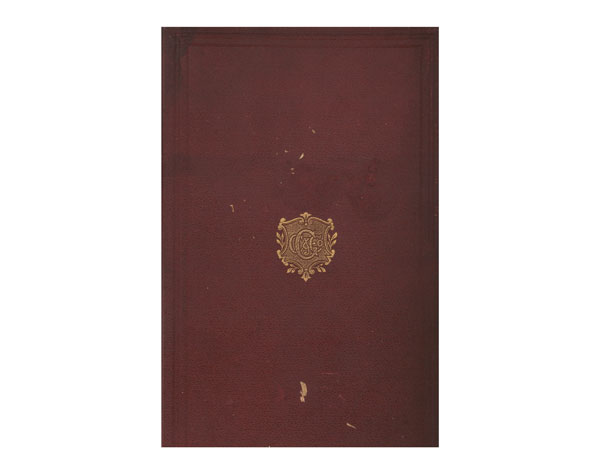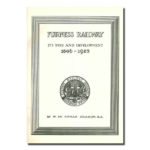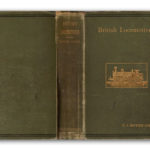Description
THE COMPOSITON OF THIS REVIEW OF A RATHER OBSCURE SUBJECT HAS BENEFITED GREATLY FROM INFORMATION IN THE STEAM INDEX http://steamindex.com/ –THE VADE MECUM OF HISTORICAL INFORMATION ON THE BRITISH STEAM RAILWAY LOCOMOTIVE.
Only three Chief Mechanical Engineers or Locomotive Superintendents wrote text books on steam locomotive design and development, C.J. Bowen Cooke of the LNWR (first edition 1893) George Hughes of the L&Y (1894) and Frank Pettigrew of the Furness. Of these the first two published earlier in their careers before attaining top rank. Pettigrew’s first edition (there were at least three) came out three years after his appointment to the Furness job, although strangely, while his membership of both the “Civils” and the “Mechanicals” is mentioned on the title page there is no reference to his official position.
Pettigrew was born in Glasgow on 24 January 1858 and was educated at Wolvesey Palace School in Winchester, Finsbury Technical College and University College, London. In 1874, aged 16, he began a five-year pupilage (presumably combined with the higher education mentioned above) under William Adams and subsequently under Massey Bromley at the Stratford Works of the Great Eastern Railway. From 1879 he worked on hydraulic cranes at Millwall and (for his father) on marine engines on the Clyde before returning to Stratford where he became a draughtsman and eventually an assistant works manager under Thomas Worsdell and then under Holden.
In March 1886 (aged 28) he was appointed works manager at Nine Elms on the London & South Western Railway, under his old chief William Adams, who seems to have thought very highly of him, to the extent of presenting a joint paper with him to the Institution of Civil Engineers “Trials of an express locomotive”. Proc. Institution Civil Engineers , 1895/6, 125, 282-95. (Trials on the LSWR between Waterloo and Bournemouth and Exeter). The paper is included in Pettigrew’s book as an appendix. It was unusual for a chief to share the limelight with a subordinate in this way; it was practically unheard of for a chief to share the credit for the design of a locomotive, as Adams did in this occasion, with a junior. It was almost as if Adams was anointing his successor. For during 1895 Adams showed increasing signs of lack of concentration, perhaps the early stages of dementia, and aged 72 was persuaded to resign.
With 9 year’s experience as works manager behind him, aged 37, Pettigrew should have been the leading contender for the job. He did not get it and became to some extent, a young man with a brilliant future behind him. Instead the board appointed Dugald Drummond (aged 55) at the suspiciously low salary of £1500 pa (he had been getting £1700pa when first appointed as Loco Supt. of the Caledonian in 1882), but had resigned to go into business (unsuccessfully) on his own account in 1890. He had therefore been out of the mainstream of loco work for five years. It has been said by Hamilton Ellis and others that while it was a contented workforce at Nine Elms under “Daddy” Adams, there was a certain lack of discipline amongst the staff which included footplatemen nipping into one of the several bars scattered around the old Waterloo station, for a quick bracer before taking a train out. Did the directors doubt Pettigrew’s ability to instill discipline? Or was there a suspicion that he had propped up the old man for too long, concealing his condition as being in his (Pettigrew’s) own best interest? In any case Drummond obviously wanted his old colleague Robert Urie (aged 43) as Works Manager, despite his comparative lack of Works management experience, and Drummond could make life very difficult for an unwanted subordinate. So Pettigrew was on his way from the 8th largest English railway designing and building its own locomotives to the Furness (19thor 22nd if Scottish railways are included) which bought all its engines off the peg from contractors. It is just worth speculating for a moment what might have happened had Pettigrew been appointed or if he had stuck it out under Drummond, and succeeded him on his retirement. Pettigrew would have been 64 n 1922, and a strong contender to be the first CME of the Southern putting in 5 years before retiring at 70…
Pettigrew arrived at Barrow as Locomotive, Carriage & Wagon superintendent of the Furness Railway with its small cramped works in 1896. The company reversed its policy of buying “off the peg” and he began designing some powerful 0-6-2 tank locomotives and some very serviceable 0-6-0 goods locomotives to replace the pretty but effete “Sharpies”, some of which dated from the 60s. He went on to design a class of passenger 4-4-0 locomotives that had more than a hint of William Adams about them but Barrow never built any locomotives, only a couple of steam railcars, and Pettigrew’s Glasgow marine engineering experience came in useful in the design of the steamer “Lady of the Lake” built by Thorneycroft for service on Coniston Water in 1908 (scrapped 1950).
Like most motive power chiefs, Pettigrew had a torrid time durIng the Great War with shortage of locomotives, arrears of maintenance, and the constant threat of losing skilled workers to better paid jobs at the adjacent Vickers armaments factory and shipyard. He also seems to have been on bad terms with David Rutherford the Furness Civil Engineer over amongst other things, derailments of his 0-6-2 tanks, so with the threat of Grouping in prospect he retired aged 60 in 1918. Chronic ill health does not seem to have been a problem, because he died aged 83 at Redhill, Surrey, in 1941.
In this writers opinion this is the best of the three books by loco department chiefs but you, dear reader, have the chance of deciding for yourself. We already have Bowen Cooke available (see below) and Hughes will be available next month.
PREVIEW BELOW – MAY TAKE A WHILE TO LOAD.




Reviews
There are no reviews yet.